Degenerate Quasilinear Hyperbolic Equation with Strong Damping
Degenerate Quasilinear Hyperbolic Equation with Strong Damping
Degenerate Quasilinear Hyperbolic Equation with Strong Damping
Create successful ePaper yourself
Turn your PDF publications into a flip-book with our unique Google optimized e-Paper software.
in<br />
Funkcialaj Ekvacioj, 27 (1984), 125-145<br />
<strong>Degenerate</strong> <strong>Quasilinear</strong> <strong>Hyperbolic</strong> <strong>Equation</strong><br />
<strong>with</strong> <strong>Strong</strong> <strong>Damping</strong><br />
By<br />
Kenji NISHIHARA<br />
(Tokyo National Technical College, Japan)<br />
1. Introduction.<br />
Let $a(¥cdot)$ be a real valued $C^{1}[0,$ $¥mathrm{o}¥mathrm{o}$)-function satisfying<br />
(1.1)<br />
$a(s)¥geq 0$ for $s¥in[0,$ $¥infty)$ .<br />
We consider the initial-boundary value problem (IBVP) for degenerate quasilinear<br />
hyperbolic equations<br />
(1.2)<br />
$u_{tt}(x, t)-a(¥int_{¥Omega}|¥nabla u(y, t)|^{2}dy)¥Delta u(x, t)-¥Delta ll_{t}(x, t)=0$<br />
the n-dimen-<br />
on where $¥Omega¥times(0, ¥infty)$ $¥Omega$ $¥partial¥Omega$<br />
is a bounded domain <strong>with</strong> its boundary<br />
sional Euclidean space . When<br />
$R^{n}$<br />
(1.3)<br />
$a(s)¥geq a_{0}>0$ for $s¥in[0,$ $¥infty)$<br />
$a_{0}$<br />
for some constant instead of (1.1), Eq. (1.2) has a classical solution <strong>with</strong> null<br />
Dirichlet boundary condition and suitable initial data, which is unique and decays<br />
$ t¥rightarrow¥infty$<br />
exponentially as .<br />
Our aim in this paper is to show the existence, uniqueness, regularity and<br />
asymptotic behaviour of the solution to (1.2) under the condition (1.1). We shall<br />
remark about the asymptotic behaviour: in general the decay property of the solution<br />
to (1.2) cannot be expected for an arbitrary . In fact, let $a$ $s_{0}$<br />
be a positive number<br />
such that $a(s_{0})=0$ and let $u_{0}(x)$ satisfy $u_{0}(x)¥in H^{¥infty}(¥Omega)$ ,<br />
$u_{0}(x)|_{¥partial¥Omega}=0$<br />
and<br />
$=s_{0}$ . Then $u(x, t)¥equiv u_{0}(x)$ is just a solution to (1.2) <strong>with</strong> initial conditions<br />
$¥int_{¥Omega}|¥nabla u_{0}(x)|^{2}dx$<br />
and boundary condition<br />
$u(x, 0)=u_{0}(x)$ , $u_{t}(x, 0)=0$<br />
$u(x, t)|_{¥partial¥Omega}=0$<br />
.<br />
We note that such $u_{0}(x)$ ’s are infinitely many, and that the above example is appli-
126 K. NISHIHARA<br />
cable to (1.4), (1.5) appeared below. However, we can prove the decay properties<br />
of the solution to (1.2) <strong>with</strong> $a(s)=s$ .<br />
We mention about related results. The equation (1.2) arises in the study of the<br />
motion of an elastic string. The equation related to (1.2) are<br />
(1.4)<br />
$u_{tt}-a(¥int_{¥Omega}|¥nabla u(y, t)|^{2}dy)¥Delta u=0$<br />
(1.5)<br />
$¥iota¥iota_{tt}-a(¥int_{¥Omega}|¥nabla u(y, t)|^{2}dy)¥Delta u+u_{t}=0$<br />
(1.6)<br />
$u_{tt}-a(¥int_{¥Omega}|¥nabla u(y, t)|^{2}dy)¥Delta u+¥Delta^{2}u=0$<br />
and etc., which are studied together <strong>with</strong> (1.3) by many authors; for (1.4) Dickey [5],<br />
[8], [9], Nishida [22], Menzala [17], Rodriguez [24], Greenberg and Hu [12], Pohozaev<br />
[23], Nishihara [20] (see also Lions [15]); for (1.5) Dickey [6], Brito [3], Yamada [27],<br />
Nishihara [21]; for (1.6) Ball [2], Dickey [7], Medeiros [16], Menzala [17], Yamaguchi<br />
[28] and others. The degenerate case is proposed in Lions [14], [15]. However, in<br />
our results the strongly damping term is necessary.<br />
The (IBVP)’s for the other (degenerate) quasilinear hyperbolic equations, such<br />
as<br />
(1.7)<br />
$u_{tt}-¥sigma(u_{x})_{x}-u_{xxt}=f$ ,<br />
are investigated by many authors, Tsutsumi [26], Andrews [1], Greenberg, MacCamy<br />
and Mizel [11], Greenberg [10] and etc., while the periodic problems to those are<br />
also studied by Clement [4], Kakita [13], Sowunmi [25], Narazaki [19] and etc.. In a<br />
final section, we shall show the existence of periodic solutions to (1.2) <strong>with</strong> the<br />
periodic forcing term when $a(s)=s$ .<br />
Acknowledgment. The author should like to express his sincere gratitude to<br />
Professor Takao Kakita for his helpful suggestions and constant encouragment and<br />
also to Professor Masaru Yamaguchi for his kind advices.<br />
2. Formulation of tke problem and results.<br />
Let $H$ $||¥cdot||$<br />
be a real, separable Hilbert space <strong>with</strong> norm and scalar product<br />
$(¥cdot, ¥cdot)$<br />
. Let A be a linear operator in $H$ <strong>with</strong> domain dense in $H$ . We assume<br />
$D(¥mathrm{A})$<br />
that A satisfies the following conditions:<br />
(HI)<br />
A is a self-adjoint, positive definite operator <strong>with</strong> discrete spectrum.<br />
$D(¥mathrm{A}^{r})$<br />
Then the linear operator A $r(r>0)$ <strong>with</strong> domain<br />
condition<br />
is<br />
well-defined and the
$D(¥mathrm{A}^{r})$<br />
<strong>Degenerate</strong> <strong>Quasilinear</strong> <strong>Hyperbolic</strong> <strong>Equation</strong> 127<br />
$i$ $D(¥mathrm{A}^{r^{¥prime}})$ $r>r^{¥prime}¥geq 0$<br />
(H2) the inject on into , , is compact<br />
is assumed. It is also assumed that<br />
$a¥in C^{1}[0,$ $¥infty$<br />
(H3) ) <strong>with</strong> $a(s)¥geq 0$ for $s¥geq 0$ .<br />
In the space $H$ we now consider the initial value problem to the equation<br />
(2. 1)<br />
$u^{¥prime¥prime}(t)+a(||¥mathrm{A}^{1/2}u(t)||^{2})¥mathrm{A}u(t)+Au^{¥prime}(t)=0$<br />
<strong>with</strong> ’boundary’ condition<br />
(2.2) $u(t)$ ,<br />
$u^{¥prime}(t)¥in D(¥mathrm{A})$<br />
for any $t¥in[0,$ $¥infty)$<br />
and initial data<br />
(2.3) $u(0)=u_{0}$ ,<br />
$u^{¥prime}(0)=u_{1}$<br />
,<br />
which is the abstract form of (IBVP) to (1.2). Here we denote $’=d_{J}/dt$ and $’’=$<br />
$d^{2}/dt^{2}$<br />
.<br />
Then<br />
$¥mathrm{v}¥mathrm{v}¥mathrm{e}$<br />
have the followings:<br />
and<br />
Theorem 1 (Existence and uniqueness).<br />
We assume the conditions $(¥mathrm{H}1)-(¥mathrm{H}3)$<br />
(H4)<br />
$u_{0}¥in D(¥mathrm{A})$<br />
and $u_{1}¥in D(¥mathrm{A}^{1/2})$ .<br />
Then there exists a unique solution $u¥in C^{1}([0, ¥infty);H)$ of $(2.1)-(¥backslash 2.3)$ satisfying Au,<br />
$¥mathrm{A}^{1/2}u^{¥prime}¥in L^{¥infty}(0, ¥infty; H)$<br />
and Au’, .<br />
$u^{¥prime¥prime}¥in L^{2}(0, ¥infty; H)$<br />
Theorem 2 (Regularity).<br />
We assume<br />
$botf¥iota u_{0}$ $u_{1}$<br />
(H3) and are<br />
belonged to $D(¥mathrm{A}^{3/2})$ .<br />
Then tfre unique solution $u$ in Theorem 1 satisfies $u¥in C^{2}([0, ¥infty);H)$ , A $3/2u$ , Au’,<br />
$¥mathrm{A}^{1/2}u^{¥prime¥prime}$<br />
$¥in L^{¥infty}(0, ¥infty;H)$ and<br />
$¥mathrm{A}^{3/2}u^{¥prime}$<br />
, Au’, .<br />
$u^{¥prime¥prime¥prime}¥in L^{2}(0, ¥infty; H)$<br />
Theorem 3 (Regularity). If we assume<br />
$u_{0}¥in D(¥mathrm{A}^{k})$<br />
(H2) $k$<br />
and , $u_{1}¥in D(¥mathrm{A}^{k-1/2})$ $k¥geq 2$ ,<br />
then the solution $u$ in Theorem 2 satisfies A $ku$ , A $k-1/2u’¥in L^{¥infty}(0, ¥infty;H)$ and A<br />
$(0, ¥infty;H)$ .<br />
$ku^{¥prime}¥in L^{2}$<br />
The bounded solution of $(2.1)-(2.3)$ obtained above cannot be expected the<br />
decay properties, as indicated in Introduction, provided that there exists $s_{0}>0$ such<br />
that $a(s_{0})=0$ . But when $a(s)=s$ we have<br />
Theorem 4 (Decay). Let (HI), (H2) and (H5) be assumed and let $u$ be<br />
$t^{l}¥iota<br />
e$<br />
unique
.<br />
and<br />
depending<br />
$00$ for some constant<br />
$a_{0}$<br />
, then it is easily seen that the<br />
solution $u(t)$ to $(2.1)-(2.3)$ <strong>with</strong> its ’higher derivatives’ decays exponentially to zero<br />
$t$<br />
as tends to infinity (cf. Nishihara [21], Yamada [27]).<br />
3. A priori estimates.<br />
We employ Galerkin’s procedure for the proofs.<br />
$¥mathrm{i}¥mathrm{m}¥mathrm{p}1_{1}^{¥tau}.¥mathrm{e}¥mathrm{s}$<br />
$¥{¥lambda_{j}^{2}¥}$<br />
The condition (HI) that A has an infinite sequence of eigenvalues<br />
<strong>with</strong><br />
an eigen-<br />
and there exists a complete orthonormal system in $¥{w_{j}¥}$ $H$ , wach $w_{j}$<br />
$¥lambda_{j}^{2}$<br />
vector to For each $u¥in H$ , we have an expantion:<br />
being<br />
$u=¥sum_{j=1}^{¥infty}u_{j}w_{j}$,<br />
$u_{j}=(u, w_{j})$<br />
<strong>with</strong> $||u||=(¥sum_{j=1}^{¥infty}u_{j}^{2})^{1/2}$ If $u¥in D(¥mathrm{A}^{k})$ , there holds<br />
A<br />
$ku=¥sum_{j=1}^{¥infty}¥lambda_{j}^{¥prime}k/l_{j}w_{j}$<br />
<strong>with</strong><br />
$||$<br />
$ku||=(¥sum_{j=1}^{¥infty}1_{j}^{4k}u_{j}^{2})^{1/2}$<br />
We now define Galerkin’s approximation $u_{m}(t)=¥sum_{j=1}^{m}g_{jm}(t)w_{j}$<br />
the initial value problem for the system:<br />
as a solution to<br />
(3. 1)<br />
$(u_{m}^{¥prime¥prime}(t)+a(||¥mathrm{A}^{1/2}u_{m}(t)||^{2})¥mathrm{A}u_{m}(t)+Au_{m}^{J}(t), w)=0$<br />
for any fixed $w¥in V^{m}$ ,<br />
<strong>with</strong> data
<strong>Degenerate</strong> <strong>Quasilinear</strong> <strong>Hyperbolic</strong> <strong>Equation</strong> 129<br />
(3.2)<br />
$u_{m}(0)=¥sum_{j=1}^{m}¥alpha_{j}w_{j}$?<br />
$u_{m}^{J}(0)=¥sum_{j=1}^{m}¥beta_{j}w_{j}$?<br />
$u_{0}$<br />
$u_{1}$<br />
strongly<br />
strongly as<br />
$<br />
as<br />
$<br />
m¥rightarrow¥infty$<br />
m¥rightarrow¥infty$<br />
,<br />
where is an $¥mathrm{m}$-dimensional vector space spanned by . Then we<br />
$V^{m}$ $¥{w_{1^{ }},--, w_{m}¥}$<br />
obtain certain nonlinear ordinary differential system for the $g_{jm}$ ’s, which has a unique<br />
$¥mathrm{C}^{3}$-solution defined on some interval [0,<br />
$t_{m}$)<br />
since .<br />
$a¥in C^{1}[0,$ $¥infty)$<br />
We estimate the under the condition (H4).<br />
$u_{m}$<br />
(I) Putting in (3. 1) we have<br />
$w=¥mathit{2}u_{m}^{J}(t)$<br />
(3.3)<br />
$¥frac{d}{dt}[||u_{m}^{¥prime}(t)||^{2}+¥hat{a}(||¥mathrm{A}^{1/2}u_{m}(t)||^{2})]+2||¥mathrm{A}^{1/2}u_{m}^{¥prime}(t)||^{2}=0$<br />
where $¥hat{a}(s)=¥int_{0}^{s}a(¥tau)d¥tau$ .<br />
(3.2), we have<br />
Integrating both sides of (3.3) from 0 to $t(t
130 K. NISHIHARA<br />
from which it follows that<br />
(3.7)<br />
$||¥mathrm{A}^{1/2}u_{m}(t)||^{2}¥leq C_{2}$<br />
and<br />
(3.8)<br />
$¥int_{0}^{t}a$<br />
$||$<br />
( A ) .<br />
$1/2u_{m}(¥tau)||^{2}$ $||¥mathrm{A}^{1/2}u_{m}(¥tau)||^{2}d¥tau¥leq C$<br />
From (3.4) and (3.7) we conclude that all the intervals [0,<br />
$t_{m}$) are extended to the<br />
$¥infty$<br />
whole interva1.[0, ).<br />
$t$<br />
(Ill) Taking $w=Au_{m}(t)$ in (3. 1) and integrating it over [0, ), we have<br />
(3.9)<br />
$a(||¥mathrm{A}^{1/2}u_{m}(t)||^{2})||$ $Au_{m}(t)||^{2}+¥frac{1}{2}¥frac{d}{dt}||$Au $m(f)||^{2}$<br />
$=-¥frac{d}{dt}(¥mathrm{A}^{1/2}u_{m}^{¥prime}(t), ¥mathrm{A}^{1/2}u_{m}(t))+||¥mathrm{A}^{1/2}u_{m}^{¥prime}(t)||^{2}$<br />
and<br />
$¥int_{0}^{t}a(||¥mathrm{A}^{1/2}u_{m}(¥tau)||^{2})||Au_{m}(¥tau)||^{2}d¥tau+¥frac{1}{2}||$<br />
Au $m(f)||^{2}$<br />
$¥leq¥frac{1}{2}||¥mathrm{A}u_{0}||^{2}+||u_{1}||||¥mathrm{A}u_{0}||+||u_{m}^{J}(t)||||¥mathrm{A}u_{m}(t)||+¥int_{0}^{t}||¥mathrm{A}^{1/2}u_{m}^{¥prime}(¥tau)||^{2}d¥tau$<br />
$¥leq C+C_{1}||$ Au$m(f)||$ ,<br />
the latter of which means<br />
(3. 10)<br />
$||$<br />
Au$m(t)||¥leq C$<br />
and<br />
(3. 11)<br />
$¥int_{0}^{¥infty}a$<br />
$||$<br />
( A ) $1/2u_{m}(¥tau)||^{2}$ $||$<br />
Au .<br />
$m(¥tau)||^{2}d¥tau¥leq C$<br />
(IV) Taking $w=¥mathit{2}Au_{m}^{J}(t)$ in<br />
$(3.¥mathrm{t})$<br />
, we have<br />
$¥frac{d}{dt}||¥mathrm{A}^{1/2}u_{m}^{¥prime}(t)||^{2}+2||$ $Au_{m}^{¥prime}(t)||^{2}=-2a$<br />
(<br />
$||$<br />
A $1/2u_{m}(t)||^{2}$ )($¥mathrm{A}u_{m}(t)$<br />
, Au )<br />
$m’(f)$<br />
$¥leq a$<br />
(<br />
$||$<br />
A ) $1/2u_{m}(t)||^{2}$ $(a_{1}||Au_{m}(t)||^{2}+¥frac{1}{a_{1}}||$ $Au_{m}^{¥prime}(t)||^{2})$<br />
that is,<br />
$¥leq a_{1}¥cdot a(||¥mathrm{A}^{1/2}u_{m}(t)||^{2})||$<br />
Au $m(t)||^{2}+||Au_{m}^{¥prime}(t)||^{2}$ ,
<strong>Degenerate</strong> <strong>Quasilinear</strong> <strong>Hyperbolic</strong> <strong>Equation</strong> 131<br />
(3.12)<br />
$¥frac{d}{dt}||¥mathrm{A}^{1/2}u_{m}^{¥prime}(t)||^{2}+||Au_{m}^{¥prime}(t)||^{2}¥leq<br />
a_{1}¥cdot a$ $||$<br />
( A ) $1/2u_{m}(t)||^{2}$ $||$<br />
Au $m(f)||^{2}$<br />
where $a_{1}=¥max¥{a(s);0¥leq s¥leq C_{2}¥}$ . Then, integrating (3. 12) over $[0, t]$ , we have<br />
$||¥mathrm{A}^{1/2}u_{m}^{¥prime}(t)||^{2}+¥int_{0}^{t}||Au_{m}^{¥prime}(¥tau)||^{2}d¥tau¥leq||$A $1/2u_{1}||^{2}+a_{1}¥int_{0}^{¥infty}a(||¥mathrm{A}^{1/2}u_{m}(¥tau)||^{2})||$<br />
Au $ m(¥tau)||^{2}d¥tau$<br />
which gives by (3.11)<br />
(3. 13)<br />
$||¥mathrm{A}^{1/2}u_{m}^{¥prime}(t)||¥leq<br />
C$<br />
and<br />
(3. 14)<br />
$¥int_{0}^{¥infty}||Au_{m}^{¥prime}(¥tau)||^{2}d¥tau¥leq<br />
(V) Putting $w=u_{m}^{¥prime¥prime}(t)$ in<br />
C$.<br />
(3. 1), we have<br />
(3. 15)<br />
$||u_{m}^{¥prime¥prime}(t)||^{2}+¥frac{1}{2}¥frac{d}{dt}||¥mathrm{A}^{1/2}u_{m}^{¥prime}(t)||^{2}=-¥frac{d}{dt}¥{a(||¥mathrm{A}^{1/2}u_{m}(t)||^{2})(¥mathrm{A}^{1/2}u_{m}(t), ¥mathrm{A}^{1/2}u_{m}^{J}(t))¥}$<br />
$+2a^{¥prime}(||¥mathrm{A}^{1/2}u_{m}(t)||^{2})(¥mathrm{A}^{1/2}u_{m}(t), ¥mathrm{A}^{1/2}u_{m}^{J}(t))^{2}+a(||¥mathrm{A}^{1/2}u_{m}(t)||^{2})||¥mathrm{A}^{1/2}u_{m}^{¥prime}(t)||^{2}$<br />
and<br />
$¥int_{0}^{t}||u_{m}^{¥prime J}(¥tau)||^{2}d_{T}+¥frac{1}{2}||¥mathrm{A}^{1/2}u_{m}^{J}(t)||^{2}$<br />
$¥leq¥frac{1}{2}||¥mathrm{A}^{1/2}u_{1}||^{2}+a_{1}||¥mathrm{A}^{1/2}u_{0}||||$<br />
A $1/2u_{1}||+a_{1}||$ A $1/2u_{m}(t)||||$ A $1/2u_{m}(t)||J$<br />
$+2a_{2}¥int_{0}^{t}||¥mathrm{A}^{1/2}u_{m}(¥tau)||^{2}||¥mathrm{A}1/2u_{m}^{;}(¥tau)||^{2}d_{T}+a_{1}¥int_{0}^{t}||¥mathrm{A}^{1/2}u_{m}^{¥prime}(¥tau)||^{2}d¥tau$.<br />
where $a_{2}=¥max¥{|a^{¥prime}(s)|; 0¥leq s¥leq C_{2}¥}$ . Hence, by (3.5), (3.7) and (3.13),<br />
$¥int_{0}^{¥infty}||u_{m}^{¥prime¥prime}(¥tau)||^{2}d¥tau¥leq $¥langle$3.<br />
16)<br />
C$.<br />
Assuming (H5) we proceed a priori estimates.<br />
Similarly to (III), taking in $w=A^{¥mathit{2}}u_{m}(t)$<br />
($¥mathrm{V}¥mathrm{D}$<br />
(3.1) derives<br />
$||¥mathrm{A}^{3/2}u_{m}(t)||¥leq C$<br />
(3. 17)<br />
and<br />
(3. 18)<br />
$¥int_{0}^{¥infty}a(||¥mathrm{A}^{1/2}u_{m}(¥tau)||^{2})||¥mathrm{A}^{3/2}u_{m}(¥tau)||^{2}d¥tau¥leq<br />
C$.
132 K. NISHIHARA<br />
(3. 19)<br />
$||$<br />
and<br />
(VII)<br />
Also, similar estimates to (IV) yield<br />
Au $mJ(t)||¥leq C$<br />
(3.20)<br />
$¥int_{0}^{¥infty}||¥mathrm{A}^{3/2}u_{m}^{¥prime}(¥tau)||^{2}d¥tau¥leq<br />
C$<br />
by virtue of (3. 18).<br />
Now we differentiate (3. 1) <strong>with</strong> respect to<br />
$t$<br />
and have<br />
(3.21)<br />
$(u_{m}^{¥prime¥prime¥prime}(t)+a(||<br />
¥mathrm{A}^{1/2}u_{m}(t)||^{2})¥mathrm{A}u_{m}^{J}(t)$<br />
$+2a^{¥prime}(||¥mathrm{A}^{1/2}u_{m}(t)||^{2})(¥mathrm{A}^{1/2}u_{m}(t), ¥mathrm{A}^{1/2}u_{m}^{J}(t))¥mathrm{A}u_{m}(I)$<br />
, $w)=0$ .<br />
(VIII) Putting<br />
$w=2¥mathrm{A}u_{m}^{¥prime¥prime}(t)$<br />
in<br />
(3.21) we have<br />
$¥frac{d}{dt}$ $||¥mathrm{A}^{1/2}u_{m}^{¥prime J}(t)||^{2}+a(||$<br />
[ A $Au_{m}^{¥prime}(t)||^{2}$] $1/2u_{m}(t)||^{2})||$ $+2||$ $Au_{m}^{¥prime¥prime}(t)||^{2}$<br />
or<br />
$=2a^{¥prime}$<br />
$||$<br />
( A ) $1/2u_{m}(t)||^{2}$ $(¥mathrm{A}^{1/2}u_{m}(t), ¥mathrm{A}^{1/2}u_{m}^{J}(t))$ $||$ $Au_{m}^{¥prime}(t)||^{2}-2(¥mathrm{A}u_{m}(t)$<br />
( , Au )<br />
$m’’(t))$<br />
(3.22)<br />
$¥frac{d}{dt}[||¥mathrm{A}^{1/2}u_{m}^{¥prime¥prime}(t)||^{2}+a(||¥mathrm{A}^{1/2}u_{m}(t)||^{2})||¥mathrm{A}u_{m}^{¥prime}(t)||^{2}]+||¥mathrm{A}u_{m}^{¥prime J}(t)||^{2}$<br />
$¥leq C$<br />
(<br />
$||$<br />
$’$<br />
$Au_{m}^{¥prime}(t)||^{2}+||$<br />
A )<br />
$1/2u_{m}(t)||^{2}$<br />
by (3.7), (3.10) and (3. 13). Integrating (3.22) over $[0, t]$ leads to<br />
(3.23)<br />
$||$<br />
$¥mathrm{A}^{1/2}u_{m}^{¥prime¥prime}(t)||¥leq C$<br />
and<br />
(3.24)<br />
$¥int_{0}^{¥infty}||$<br />
$Au_{m}^{¥prime¥prime}(¥tau)||^{2}d¥tau¥leq C$.<br />
Here<br />
$||¥mathrm{A}^{1/2}u_{m}^{¥prime¥prime}(0)||^{2}¥leq<br />
C$<br />
follows from (3.1) and (H5).<br />
(IX)<br />
(3.21) <strong>with</strong> (3.5), (3.7), (3. [0, (3. 14) and (3.24) yields<br />
(3.25)<br />
$¥int_{0}^{¥infty}||u_{m}^{¥prime¥prime¥prime}(¥tau)||^{2}d_{T}¥leq<br />
C$<br />
.<br />
4. Proof of Theorem 1.<br />
By virtue of a priori estimates (3.10), (3.13), (3. 14) and (3.25),<br />
of <strong>with</strong> the properties<br />
$¥{u_{m}¥}$<br />
subsequence<br />
$¥{u_{¥mu}¥}$<br />
we may extract a
u^{¥prime}$<br />
in<br />
u^{¥prime¥prime}$<br />
in<br />
<strong>Degenerate</strong> <strong>Quasilinear</strong> <strong>Hyperbolic</strong> <strong>Equation</strong> 133<br />
(4. 1)<br />
$u_{¥mu}¥rightarrow<br />
$u_{¥mu}^{¥prime}¥rightarrow<br />
(4.2)<br />
$u_{¥mu}^{¥prime¥prime}¥rightarrow<br />
(4.3)<br />
u$ in<br />
$¥mathrm{w}¥mathrm{e}¥mathrm{a}¥mathrm{k}1¥mathrm{y}^{*}$<br />
$L^{¥infty}(0, ¥infty; D(¥mathrm{A}))$<br />
$L^{¥infty}(0, ¥infty; D(¥mathrm{A}^{1/2}))¥cap L^{2}(0, ¥infty;D(¥mathrm{A}))$<br />
$¥mathrm{w}¥mathrm{e}¥mathrm{a}¥mathrm{k}1¥mathrm{y}^{*}$<br />
$L^{2}(0, ¥infty; H)$ weakly<br />
and<br />
(4.4)<br />
$a(||¥mathrm{A}^{1/2}u_{¥mu}(¥cdot)||^{2})¥mathrm{A}u_{¥mu}$<br />
for some $u$ and<br />
$¥chi$<br />
.<br />
?<br />
in<br />
$L^{¥infty}(0, ¥infty; H)$ $¥mathrm{w}¥mathrm{e}¥mathrm{a}¥mathrm{k}1¥mathrm{y}^{*}$<br />
We must show $¥chi_{=a}(||¥mathrm{A}^{1/2}u(¥cdot)||^{2})¥mathrm{A}u$ . For any $¥phi¥in C_{0}(0, ¥infty; H)$ and $T>0$ we<br />
have<br />
$¥int_{0}^{T}(¥chi-a(||¥mathrm{A}^{1/2}u(¥tau)||^{2})¥mathrm{A}u(¥tau), ¥phi)dt=¥int_{0}^{T}(¥chi-a(||¥mathrm{A}^{1/2}u_{¥mu}(¥tau)||^{2})¥mathrm{A}u_{¥mu}(¥tau), ¥phi)d¥tau$<br />
(4. 5)<br />
$+¥int_{0}^{T}a$<br />
(<br />
$||$<br />
A $1/2u(¥tau)||^{2}$ )($¥mathrm{A}u_{¥mu}(¥tau)-$<br />
Au(),<br />
$¥phi$)<br />
$ d¥tau$<br />
$+¥int_{0}^{T}$<br />
$(a(||¥mathrm{A}^{1/2}u_{¥mu}(¥tau)||^{2})-a(||¥mathrm{A}^{1/2}u(¥tau)||^{2}))(¥mathrm{A}u_{¥mu}(¥tau), ¥phi)d¥tau$.<br />
But, by the mean value theorem and by (4. 1) and (H2),<br />
$|$<br />
the last term in $(4.5)|$<br />
$¥leq C¥int_{0}^{T}a_{2}|$<br />
($¥mathrm{A}^{1/2}u_{¥mu}(¥tau)-¥mathrm{A}^{1/2}u(¥tau)$<br />
,<br />
A $1/2u_{¥mu}(¥tau)+¥mathrm{A}^{1/2}u(¥tau)$ ) $|d¥tau$<br />
$¥leq C¥int_{0}^{T}||¥mathrm{A}^{1/2}u_{¥mu}(¥tau)-¥mathrm{A}^{1/2}u(¥tau)||d¥tau¥rightarrow 0$<br />
as $¥mu¥rightarrow¥infty$<br />
.<br />
The other integrals in right-hand side in (4.5) also tend to zero. The arbitrariness<br />
$¥phi$<br />
of and $T$ implies . Hence we get (2.1) for almost all $¥chi_{=a}(||¥mathrm{A}^{1/2}u(¥cdot)||^{2})¥mathrm{A}u$ $t$<br />
. The<br />
initial conditions (2.3) follow from (4.3) and the next Lemma 1.<br />
Lemma 1 (Ball [2]). Let $X$ be a Banach space. If $f¥in L^{2}(0, T;X)$ and<br />
$f^{¥prime}¥in L^{2}$<br />
$(0, T;X)$ , then $f$ , possibly after redefinition on a set of measure zero, is continuous from<br />
$[0, T]$ to $X$ .<br />
Thus the existence part of Theorem 1 is completed.<br />
In order to prove the uniqueness part, let and be two solutions of $u$ $v$ $(2.1)-$<br />
$(2.3)$ . Then $w¥equiv u-v$ satisfies<br />
(4. 6)<br />
and<br />
$w^{¥prime¥prime}(t)+a(||¥mathrm{A}^{1/2}u(t)||^{2})¥mathrm{A}w(t)+¥mathrm{A}w^{¥prime}(t)$<br />
$=-$ [ $a(||¥mathrm{A}^{1/2}u(t)||^{2})-a(||$ A $1/2u(t)||^{2})$ ]<br />
$¥mathrm{A}v(t)$
134 K. NISHIHARA<br />
(4.7) $w(0)=0$, $w^{¥prime}(0)=0$ .<br />
Applying , $2w^{¥prime}(t)+¥mathcal{T}w(t)$ $0
<strong>Degenerate</strong> <strong>Quasilinear</strong> <strong>Hyperbolic</strong> <strong>Equation</strong> 135<br />
and<br />
(5.4)<br />
$u^{¥prime¥prime¥prime}¥in L^{2}(0, ¥infty;H)$<br />
by (3.16)?(3.19) and (3.22)?(3.24). Combining Lemma 1 and $(5.1)-(54)$ implies<br />
$u¥in C^{2}(.[0, ¥infty);H)$ .<br />
Q.E.D.<br />
Proof of Theorem 3. Putting $w=¥mathrm{A}^{2k-1}u_{m}(t)$ , $k=2,3$ ,<br />
$¥cdots$<br />
, in (3.1) and integrating<br />
it from 0 to<br />
$t$,<br />
(5. 5)<br />
$||$<br />
and<br />
we obtain<br />
A $ku_{m}(t)||¥leq C$<br />
(5.6)<br />
$¥int_{0}^{¥infty}a(||¥mathrm{A}^{1/2}u_{m}(¥tau)||^{2})||$A<br />
$ku_{m}(¥tau)||^{2}d_{T}¥leq C$<br />
by the similar way to (III).<br />
(5.7)<br />
$||$<br />
and<br />
Then, similarly to (IV), we get<br />
A<br />
$k-1/2u_{m}^{¥prime}(t)||^{2}¥leq C$<br />
(5.8)<br />
$¥int_{0}^{¥infty}||$<br />
A<br />
$ku_{m}^{¥prime}(¥tau)||^{2}d¥tau¥leq C$ ,<br />
using (5.6). Hence Theorem 3 follows from (5.5), (5.7) and (5.8) Q.E.D.<br />
6. Proof of Theorem 4.<br />
From Theorem 2 it suffices to obtain the apriori estimates $(2.5)-(2.9)$ to $u_{m}(t)_{>}$<br />
which satisfies<br />
(6.1)<br />
$(u_{m}^{¥prime¥prime}(t)+||¥mathrm{A}^{1/2}u_{m}(t)||^{2}Aum(t)+Au_{m}^{J}(t), w)=0$<br />
for any<br />
$w¥in V^{m}$<br />
together <strong>with</strong> (3.2). Since $a(s)=s$, (3.5) and (3.8) give<br />
(6.2)<br />
$¥int_{0}^{t}||$<br />
$¥mathrm{A}^{1/2}u^{J}(¥tau)||^{2}d¥tau¥leq C$<br />
and<br />
(6.3)<br />
$¥int_{0}^{t}||¥mathrm{A}^{1/2}u(¥tau)||^{4}d¥tau¥leq<br />
C$<br />
.<br />
(From now on we abbreviate the suffix $m$<br />
for simplicity.)<br />
Multiplying (3.3) by $(1+t)$ and integrating it over $[0, t]$ , we have
136 K. NISHIHARA<br />
$¥frac{d}{dt}[(1+t)(||u^{¥prime}(t)||^{2}+¥frac{1}{2}||¥mathrm{A}^{1/2}u(t)||^{4})]+2(1+t)||¥mathrm{A}^{1/2}u^{¥prime}(t)||^{2}$<br />
$=||u^{j}(t)||^{2}+¥frac{1}{2}||¥mathrm{A}^{1/2}u(t)||^{4}$<br />
and<br />
(6. 4)<br />
$(1+t)(||u^{¥prime}(t)||^{2}+¥frac{1}{2}||¥mathrm{A}^{1/2}u(t)||^{4})+2¥int_{0}^{t}(1+¥tau)||¥mathrm{A}^{1/2}u^{¥prime}(¥tau)||^{2}d¥tau$<br />
$¥leq||u_{1}||^{2}+¥frac{1}{2}||u_{0}||^{4}+¥int_{0}^{t}(||u^{¥prime}(¥tau)||^{2}+¥frac{1}{2}||¥mathrm{A}^{1/2}u(¥tau)||^{4})d¥tau$<br />
.<br />
By virtue of (6.2), (6.3) and (H5), (6.4) gives<br />
(6.3)<br />
$(1+t)||u^{¥prime}(t)||^{2}¥leq C$<br />
(6.6)<br />
$(1+t)||¥mathrm{A}^{1/2}u(t)||^{4}¥leq C$<br />
and<br />
(6.7)<br />
$¥int_{0}^{t}(1+¥tau)||¥mathrm{A}^{1/2}u^{¥prime}(¥tau)||^{2}d¥tau¥leqq C$.<br />
Multiplying (3.6) by $(1+t)^{1/2-¥epsilon}$ for small positive constant<br />
$¥epsilon$<br />
, we have<br />
$(1+t)^{1/2-¥epsilon}||¥mathrm{A}^{1/2}u(t)||^{4}+¥frac{1}{2}¥frac{d}{dt}(1+t)^{1/2-¥epsilon}||$A $1/2u(t)||^{2}$<br />
$=¥frac{1}{2}(1/2-¥epsilon)(1+t)^{-1/2-¥epsilon}||¥mathrm{A}^{1/2}u(t)||^{2}+(1+t)^{1/2-¥epsilon}||u^{¥prime}(t)||^{2}$<br />
$-¥frac{d}{dt}(1+t)^{1/2-8}(u^{¥prime}(t), u(t))+(1/2-¥epsilon)(1+t)^{-1/2-¥epsilon}(u^{¥prime}(t), u(t))$<br />
which yields, by integration over $[0, t]$ and by (6.2)?(6.3), $(6.5)-(6.7)$ ,<br />
$¥int_{0}^{t}(1+¥tau)^{1/2-¥epsilon}||¥mathrm{A}^{1/2}u(¥tau)||^{4}d¥tau+¥frac{1}{2}(1+t)^{1/2-¥epsilon}||¥mathrm{A}^{1/2}u(t)||^{2}$<br />
$¥leq¥frac{1}{2}||¥mathrm{A}^{1/2}u_{0}||^{2}+||u_{1}||||u_{0}||+(1+t)^{1/2-¥epsilon}||u^{¥prime}(t)||||u(t)||+¥frac{1}{4}¥int_{0}^{t}(1+¥tau)^{-1/2-¥epsilon}||¥mathrm{A}^{1/2}u(¥tau)||^{2}d¥tau$<br />
$+¥int_{0}^{t}(1+¥tau)^{1/2-¥epsilon}||u^{¥prime}(¥tau)||^{2}d¥tau+¥frac{1}{2}¥int_{0}^{t}(1+¥tau)^{-1/2-¥epsilon}||u^{¥prime}(¥tau)||||u(¥tau)||d¥tau$<br />
$¥leq C+¥{(1+t)||u^{¥prime}(t)||^{2}¥}^{1/2}||u(t)||+¥frac{1}{¥lambda_{1}^{2}}¥int_{0}^{t}(1+¥tau)||$A $1/2u(¥tau)||^{2}d¥tau’$<br />
$+¥frac{1}{4}(¥int_{0}^{¥infty}(1+¥tau)^{-1-2¥epsilon}d¥tau)^{1/2}(¥int_{0}^{¥infty}||¥mathrm{A}^{1/2}u(¥tau)||^{4}d¥tau)^{1/2}$<br />
$+¥frac{1}{2¥lambda_{1}}¥max||u(¥tau)||¥cdot(¥int_{0}^{¥infty}(1+¥tau)^{-1-2¥epsilon}d¥tau)^{1/2}(¥int_{0}^{¥infty}||¥mathrm{A}^{1/2}u^{¥prime}(¥tau)||^{2}d¥tau)^{1/2}¥leq C_{2¥epsilon}$ .
}¥mathrm{i}¥mathrm{v}¥mathrm{e}¥mathrm{s}$<br />
$(2.5)$<br />
}t]$<br />
,<br />
Here we denote by<br />
$C_{¥epsilon}$<br />
<strong>Degenerate</strong> <strong>Quasilinear</strong> <strong>Hyperbolic</strong> <strong>Equation</strong> 13”<br />
the constant depending only upon<br />
$¥int_{0}^{¥infty}(1+¥tau)^{-1-¥epsilon}d¥tau$<br />
.<br />
Hence we obtain<br />
(6. 8)<br />
$¥int_{0}^{t}(1+¥tau)^{1/2-¥epsilon}||$<br />
A $1/2u(¥tau)||^{4}d¥tau¥leq C_{2¥epsilon}$ .<br />
By induction we shall show<br />
$¥langle$6.9)<br />
$¥int_{0}^{t}(1+¥tau)^{1-¥epsilon}||¥mathrm{A}^{1/2}u(¥tau)||^{4}d¥tau¥leq<br />
C_{¥epsilon/2}$<br />
(6. 10)<br />
$(1+t)^{1-¥epsilon}||¥mathrm{A}^{1/2}u(t)||^{2}¥leq C_{¥epsilon/2}$,<br />
the latter of which<br />
$¥mathrm{g}_{¥backslash<br />
. For $N¥geq 1$ we assume<br />
$(6.11)_{N}$<br />
$¥int_{0}^{t}(1+¥tau)^{1-2^{-N}-¥epsilon/2}||¥mathrm{A}^{1/2}u(¥tau)||^{4}d¥tau¥leq C_{¥epsilon/2}$<br />
$(6.12)_{N}$ $(1+t)^{1- 2-¥epsilon/2}-N||$ $¥mathrm{A}^{1/2}u(t)||^{2}¥leq C_{¥epsilon/2}$<br />
.<br />
Note that and are valid from (6.8) and (6.6). Multiplying (3.6) by<br />
$(6.11)_{1}$ $(6.12)_{1}$<br />
$(1+t)^{1-2-¥epsilon/2}-N-1$ and integrating it over<br />
$[¥mathrm{O}_{¥backslash<br />
we get<br />
$(1+t)^{1-2-¥epsilon/2}-N-1||¥mathrm{A}^{1/2}u(t)||^{4}+¥frac{1}{2}¥frac{d}{dt}(1+t)^{1- 2-¥epsilon/2}-N-1||¥mathrm{A}^{1/2}u(t)||^{2}$<br />
$=¥frac{1}{2}(1-2^{-N-1}-¥epsilon/2)(1+t)^{-2-¥epsilon/2}-N-1||¥mathrm{A}^{1/2}u(t)||^{2}$<br />
$+(1+t)^{1-2-¥epsilon/2}-N-1||u^{¥prime}(t)||^{2}-¥frac{d}{dt}(1+t)^{1-2-¥epsilon/}-N-12(u^{¥prime}(t), u(t))$<br />
and<br />
$+(1-2^{-N-1}-¥epsilon/2)(1+t)^{-2-¥epsilon/2}-N-1(u^{¥prime}(t), u(t))$<br />
$¥int_{0}^{t}(1+¥tau)^{1-N-1}-2-¥epsilon/2||$ A $1/2u(¥tau)||^{4}d_{T}+¥frac{1}{2}(1+t)^{1-N-1}-2-¥epsilon/2||$ A $1/2u(t)||^{¥mathrm{z}}$<br />
$¥leq¥frac{1}{2}||¥mathrm{A}^{1/2}u_{0}||^{2}+||u_{1}||||u_{0}||+¥frac{1}{2}(¥int_{0}^{¥infty}(1+¥tau)^{-1-¥epsilon/2}d¥tau)^{1/2}$<br />
$¥times(¥int_{0}^{¥infty}(1+¥tau)^{-1- 2-¥epsilon/2}-N||¥mathrm{A}^{1/2}u(¥tau)||^{4}d¥tau)^{1/2}+¥frac{1}{¥lambda_{1}^{2}}¥int_{0}^{¥infty}(1+¥tau)||¥mathrm{A}^{1/2}u^{¥prime}(¥tau)||^{2}d¥tau$<br />
$+¥frac{1}{¥lambda_{1}}¥{(1+t)||u^{¥prime}(t)||^{2}¥}^{1/2}¥{(1+t)^{1-2-¥epsilon/2}-N||¥mathrm{A}^{1/2}u(t)||^{2}¥}^{1/2}$<br />
$+¥frac{1}{¥lambda_{1}}¥sup_{¥tau}||u(¥tau)||¥cdot(¥int_{0}^{¥infty}(1+¥tau)^{-1-¥epsilon}d¥tau)^{1/2}(¥int_{0}^{¥infty}(1+¥tau)||¥mathrm{A}^{1/2}u^{¥prime}(¥tau)||^{2}d¥tau)^{1/2}¥leq C_{¥epsilon/2}$.
138 K. NISHIHARA<br />
This shows $(6.11)_{N+1}$ and $(6.12)_{N+1}$ . Thus we obtain (6.9) and (6. 10) by selecting $N$<br />
$2^{-N}
$||$<br />
Au<br />
<strong>Degenerate</strong> <strong>Quasilinear</strong> <strong>Hyperbolic</strong> <strong>Equation</strong> 139<br />
(6. 16)<br />
$(1+t)^{3/2-¥epsilon}||$ A $1/2u(t)||¥leq C_{¥epsilon/12}’$ .<br />
(6. 16) gives (2.7).<br />
In (3.21), putting $w=2(1+t)^{4-¥epsilon}u^{¥prime¥prime}(t)$ and integrating it from 0 to<br />
$t$<br />
, we obtain<br />
$¥frac{d}{dt}$<br />
[ A ] $(1+t)^{4-¥epsilon}(||u^{¥prime¥prime}(t)||^{2}+||$ $1/2u(t)||^{2}||¥mathrm{A}^{1/2}u^{¥prime}(t)||^{2})$ $+2(1+t)^{4-¥epsilon}||$ A $l/2u(t)||^{2}’’$<br />
$=(4-¥epsilon)(1+t)^{3-6}(||u^{¥prime¥prime}(t)||^{2}+||¥mathrm{A}^{1/2}u(t)||^{2}||¥mathrm{A}^{1/2}u^{¥prime}(t)||^{2})$<br />
$+2(1+t)^{4-¥epsilon}$ (Au(t),<br />
$u^{¥prime}(t)$<br />
$(|| ¥mathrm{A}^{1/2}u^{¥prime}(t)||^{2}-2(¥mathrm{A}u(t), u^{¥prime¥prime}(t)))$<br />
)<br />
and<br />
$(1+t)^{4-¥epsilon}[||u^{¥prime¥prime}(t)||^{2}+||¥mathrm{A}^{1/2}u(t)||^{2}||¥mathrm{A}^{1/2}u^{¥prime}(t)||^{2}]+2¥int_{0}^{t}(1+¥tau)^{4-¥epsilon}||¥mathrm{A}^{1/2}u^{¥prime¥prime}(¥tau)||^{2}d¥tau$<br />
$¥leq||u^{¥prime¥prime}(0)||^{2}+||¥mathrm{A}^{1/2}u_{0}||^{2}||¥mathrm{A}^{1/2}u_{1}||^{2}+4¥int_{0}^{¥infty}(1+¥tau)^{3-¥epsilon}||u^{¥prime¥prime}(¥tau)||^{2}d¥tau$<br />
$+4¥sup_{¥tau}$ { $(1+¥tau)^{1-¥epsilon/2}||$ A $1/2u(¥tau)||^{2}$ }<br />
$¥int_{0}^{¥infty}(1+¥tau)^{2-¥epsilon/2}||$<br />
A $1/2u(¥tau)||^{2}d¥tau’$<br />
$+2[¥sup_{¥tau}¥{(1+¥tau)^{1-2¥epsilon/3}||¥mathrm{A}^{1/2}u^{¥prime}(¥tau)||^{2}¥}]^{1/2}¥sup_{¥tau}${<br />
A }<br />
$(1+¥tau)^{3/2-¥epsilon/3}||$ $1/2u(¥tau)||$<br />
$’$<br />
$¥times¥int_{0}^{¥infty}(1+¥tau)^{2-¥epsilon/3}||$<br />
A $1/2u(¥tau)||^{2}d¥tau+4¥sup_{¥tau}${<br />
$(1’+¥tau)^{1-¥epsilon/6}||$ A }<br />
$1/2u(¥tau)||^{2}$<br />
$¥times¥sup_{¥tau}¥{(1+¥tau)^{3/2-¥epsilon/6}||¥mathrm{A}^{1/2}u^{¥prime}(¥tau)||¥}(¥int_{0}^{¥infty}(1+¥tau)^{-1-¥epsilon¥prime 3}d¥tau)^{1/2}$<br />
$¥times(¥int_{0}^{t}(1+¥tau)^{4-¥epsilon}||¥mathrm{A}^{1/2}u^{¥prime¥prime}(¥tau)||^{2}d¥tau)^{1/2}$<br />
$¥leq C_{¥epsilon/9}+C_{¥epsilon/18}(¥int_{0}^{t}(1+¥tau)^{4-¥epsilon}||¥mathrm{A}^{1/2}u^{¥prime¥prime}(¥tau)||^{2}d¥tau)^{1/2}$<br />
which gives (2.8), (2.9).<br />
Finally we show (2.6).<br />
In fact, by the Cauchy-Schwarz inequality<br />
$||^{4}=(¥sum¥lambda_{j}^{4}g_{jm}^{2})^{2}¥leq(¥sum¥lambda_{j}^{2}g_{jm}^{2})(¥sum¥lambda_{j}^{6}g_{jm}^{2})=||$ A $1/2u||^{2}||¥mathrm{A}^{3/2}u||^{2}$<br />
and hence, by (6.9) and (3.17),<br />
$(1+t)^{1-¥epsilon}||u(t)$ $||^{4}¥leq(1+t)^{1-¥epsilon}||¥mathrm{A}^{1/2}u(t)||^{2}¥cdot||$ $¥mathrm{A}^{3/2}u(t)||^{2}¥leq C_{¥epsilon/2}$<br />
.<br />
Thus the proof of Theorem 4 is completed.<br />
$¥mathrm{Q}.¥mathrm{E}$.D.<br />
7. Periodic solution.<br />
In this section we seek the $¥omega$-periodic solution $u(t)$ to the equation<br />
(7. 1)<br />
$u^{¥prime¥prime}(t)+||¥mathrm{A}^{1/2}u(t1||^{2}Au(t)+Au^{¥prime}(t)=f(t)$ in $H$
degree<br />
,<br />
140 K. NISHIHARA<br />
where : $f$ $(-¥infty, ¥infty)¥rightarrow H$<br />
is an $¥omega$-periodic function. When $X$ is a Banach space <strong>with</strong><br />
$||¥cdot||_{X}$<br />
norm , $L^{p}(¥omega; X)$ means the space of functions $f(t)¥in X$<br />
$ t¥in$<br />
for each $(-¥infty, ¥infty)$<br />
and periodic, <strong>with</strong> period<br />
$¥omega$<br />
, such that , equipped <strong>with</strong> norm<br />
$¥int_{0}^{¥omega}||f(t)||_{X}^{p}dt
$¥epsilon||$<br />
<strong>Degenerate</strong> <strong>Quasilinear</strong> <strong>Hyperbolic</strong> <strong>Equation</strong> 141<br />
(7.5)<br />
$¥int_{¥omega}||¥mathrm{A}^{1/2}u_{m}^{J}(¥tau)||^{2}d¥tau¥leq¥frac{1}{¥lambda_{1}^{2}}¥int_{¥omega}||f(¥tau)||^{2}d¥tau¥equiv<br />
C_{3}$<br />
by integration of (7.4) over $[t, t+¥omega]$ $¥int_{t}^{t+¥omega}=¥int_{¥omega}$<br />
and (7.3), where we denote for<br />
simplicity. (In this section several constants $C$ $C_{i}$ $t$<br />
and are independent of , $m$ and<br />
$¥epsilon.)$<br />
If we put $w=u_{m}$ in (7.2), then we have<br />
$¥frac{d}{dt}(u_{m}^{¥prime}(t), u_{m}(t))-||u_{m}^{¥prime}(t)||^{2}+¥epsilon||¥mathrm{A}^{1/2}u_{m}(t)||^{2}+||¥mathrm{A}^{1/2}u_{m}(t)||^{4}$<br />
$+¥frac{1}{2}¥frac{d}{dt}||¥mathrm{A}^{1/2}u_{m}(t)||^{2}=(f(t), u_{m}(t))$<br />
and<br />
$¥int_{¥omega}||¥mathrm{A}^{1/2}u_{m}(¥tau)||^{4}d¥tau¥leq C_{3}/¥lambda_{1}^{2}+¥frac{1}{2¥lambda_{1}}¥int_{¥omega}||f(¥tau)||^{2}d¥tau+¥frac{¥vee¥overline{¥omega}}{2¥lambda_{1}}(¥int_{¥omega}||$<br />
A $1/2l_{m}^{¥prime}(¥tau)||^{4}d¥tau)^{1/2}$<br />
and hence<br />
(7.6)<br />
$¥int_{¥omega}||$<br />
A<br />
$1/2u_{m}(¥tau)||^{4}d¥tau¥leq C$ .<br />
By virtue of (7.5) and (7.6) there exists<br />
$t_{0}¥in[0, ¥omega]$<br />
such<br />
that<br />
$||u_{m}^{J}(t_{0})||$<br />
,<br />
$||$<br />
$¥mathrm{A}^{1/2}u_{m}(t_{0})||¥leq C$<br />
from which and (7.4) it follows that, for $t¥in[t_{0}, t_{0}+¥omega]$ ,<br />
$||u_{m}^{¥prime}(t)||^{2}+¥epsilon||¥mathrm{A}^{1/2}u_{m}(t)||^{2}+¥frac{1}{2}||$<br />
A $ 1/2u_{m}(t)||^{4}+¥int_{t¥mathrm{o}}^{t}||¥mathrm{A}^{1/2}u_{m}^{J}(¥tau)||^{2}d¥tau$<br />
$¥leq||u_{m}^{¥prime}(t_{0})||^{2}+¥epsilon||¥mathrm{A}^{1/2}u_{m}(t_{0})||^{2}+¥frac{1}{2}||¥mathrm{A}^{1/2}u_{m}(t_{0})||^{4}+¥frac{1}{¥lambda_{1}^{2}}¥int_{t¥mathrm{o}}^{t}||f(¥tau)||^{2}d¥tau$ ,<br />
that is,<br />
(7.7)<br />
$||u_{m}^{j}(t)||¥leq C$<br />
and<br />
$||¥mathrm{A}^{1/2}u_{m}(t)||^{2}¥leq C_{4}$<br />
.<br />
Taking $w=Au_{m}$ in (7.2) and integrating it over $[t, t+¥omega]$ ,<br />
we have<br />
(7. 8)<br />
Au$m(t)||^{2}+||$ A $1/2u_{m}(t)||^{2}||$ Au<br />
$m(f)||^{2}+¥frac{1}{2}¥frac{d}{dt}||$ $Au_{m}(t)||^{2}$<br />
$=(¥mathrm{A}^{1/2}f(t), ¥mathrm{A}^{1/2}u_{m}(t))+||¥mathrm{A}^{1/2}u_{m}^{¥prime}(t)||^{2}-¥frac{d}{dt}(¥mathrm{A}^{1/2}u_{m}^{¥prime}(t), ¥mathrm{A}^{1/2}u_{m}(t))$<br />
and
Au<br />
to<br />
142 K. NISHIHARA<br />
(7.9)<br />
$¥int_{¥omega}||¥mathrm{A}^{1/2}u_{m}(¥tau)||^{2}||$<br />
Au<br />
$m(¥tau)||^{2}d¥tau¥leq¥int_{¥omega}||¥mathrm{A}^{1/2}u_{m}^{J}(¥tau)||^{2}d_{T}+¥int_{¥omega}(¥mathrm{A}^{1/2}f(¥tau), ¥mathrm{A}^{1/2}u_{m}(¥tau))d¥tau¥leq C$<br />
by (7.5) and (7.6). Putting<br />
$¥mathrm{w}=2¥mathrm{A}¥mathrm{u}_{m}^{J}$<br />
in<br />
(7.2) we have<br />
$¥frac{d}{dt}$ $||¥mathrm{A}^{1/2}u_{m}^{J}(t)||^{2}+¥epsilon||$<br />
( Au ) $m(t)||^{2}$ $Au_{m}^{¥prime}(t)||^{2}$<br />
$+2||$<br />
$=2$ ( $f(t)$ , Au $m’(f)$ ) $-2||¥mathrm{A}^{1/2}u_{m}(t)||^{2}$ (Au $m(t)$ , Au $m’(f)$ )<br />
$¥leq||¥mathrm{A}^{1/2}f(t)||^{2}+||$<br />
A $1/2u_{m}^{;}(t)||^{2}+||¥mathrm{A}^{1/2}u_{m}(t)||^{2}(C_{4}||$<br />
Au $m(t)||^{2}+¥frac{1}{C_{4}}||Au_{m}^{¥prime}(t)||^{2})$<br />
and<br />
(7. 10)<br />
$¥frac{d}{dt}$ $||¥mathrm{A}^{1/2}u_{m}^{¥prime}(t)||^{2}+¥epsilon||$<br />
( Au ) $m(f)||^{2}$ $+||$ $Au_{m}^{J}(t)||^{2}$<br />
$¥leq||¥mathrm{A}^{1/2}f(t)||^{2}+||$<br />
A $1/2u_{m}^{¥prime}(t)||^{2}+C_{4}||¥mathrm{A}^{1/2}u_{m}(t)||^{2}||$ Au $m(f)||^{2}$ .<br />
Then, integrating (7. 10) over<br />
$[t, t+¥omega]$ and<br />
using (7.7), (7.9), we have<br />
(7. 11)<br />
$¥int_{¥omega}||$<br />
$Au_{m}^{J}(¥tau)||^{2}d¥tau¥leq C$<br />
$||$<br />
which implies for some . Integrating (7.10) from $mJ(t_{1})||¥leq C$ $t_{1}¥in[0, ¥omega]$ $t_{1}$<br />
$[t_{1}, t_{1}+¥omega]$<br />
, we obtain<br />
$t$<br />
$ t¥in$<br />
,<br />
(7. 12)<br />
$||$<br />
Putting<br />
$¥mathrm{w}=¥mathrm{A}^{2}¥mathrm{u}_{m}$<br />
in<br />
$¥mathrm{A}^{1/2}u_{m}^{¥prime}(t)||¥leq C$<br />
.<br />
(7.2) and integrating it over $[t, t+¥omega]$ , we get<br />
$¥epsilon¥int_{¥omega}||¥mathrm{A}^{3/2}u_{m}(¥tau)||^{2}d¥tau+¥int_{¥omega}||¥mathrm{A}^{1/2}u_{m}(¥tau)||^{2}||$A $ 3/2u_{m}(¥tau)||^{2}d¥tau$<br />
(7. 13)<br />
$¥leq¥frac{1}{2}¥int_{¥omega}||¥mathrm{A}f(¥tau)||^{2}d_{T}+¥frac{1}{2}¥int_{¥omega}||$<br />
A $ll_{m}(¥tau)||^{2}d¥tau+¥int_{¥omega}||$ $ Au_{m}^{¥prime}(¥tau)||^{2}d¥tau$ .<br />
By virtue of the Cauchy-Schwarz inequality it holds<br />
Hence<br />
$||$<br />
Au .<br />
$m||^{2}¥leq||¥mathrm{A}^{1/2}u_{m}||||¥mathrm{A}^{3/2}u_{m}||$<br />
$¥int_{¥omega}||$<br />
$Au_{m}(¥tau)||^{4}d¥tau¥leq¥frac{1}{2}¥int_{¥omega}||¥mathrm{A}f(¥tau)||^{2}d¥tau+¥frac{¥vee¥overline{¥omega}}{2}(¥int_{¥omega}||$ $Au_{m}(¥tau)||^{4}d¥tau)^{1/2}+¥int_{¥omega}||$ $ Au_{m}^{¥prime}(¥tau)||^{2}d¥tau$<br />
and<br />
(7. 14)<br />
$¥int_{¥omega}||$<br />
Au<br />
$m(¥tau)||^{4}d¥tau¥leq C$ .
Au<br />
Au<br />
It also follows from (7. 13) that<br />
<strong>Degenerate</strong> <strong>Quasilinear</strong> <strong>Hyperbolic</strong> <strong>Equation</strong> 143<br />
(7. 15)<br />
$¥int_{¥omega}¥epsilon||¥mathrm{A}^{3/2}u_{m}(¥tau)||^{2}d¥tau+¥int_{¥omega}||¥mathrm{A}^{1/2}u_{m}(¥tau)||^{2}||$<br />
$¥mathrm{A}^{¥mathrm{S}/2}u_{m}(¥tau)||^{2}d¥tau¥leq C$.<br />
From (7.14) there exists such that $t_{2}¥in[0, ¥omega]$ $||$<br />
$Au_{m}(t_{2})||¥leq C$ . If we consider (7.8) as<br />
$||$<br />
the first order differential equation in <strong>with</strong> the initial value $m(f)||^{2}$ $||$<br />
$Au_{m}(t_{2})||^{2}$<br />
at<br />
$t$<br />
$t=t_{2}$ $ t_{2}¥leq t¥leq t_{2}+¥omega$<br />
, then we have for , ,<br />
$||$<br />
$Au_{m}(t)||^{2}=e^{-P(t)}$ [<br />
$||$ $m(t_{¥mathrm{z}})||^{2}-2(¥mathrm{A}^{1/2}u_{m}^{¥prime}(t_{2}),$ $¥mathrm{A}^{1/2}u_{m}(t_{2}))$<br />
Au ]<br />
$+2(¥mathrm{A}^{1/2}u_{m}^{J}(t), ¥mathrm{A}^{1/2}u_{m}(t))+2e^{-P(b)}¥int_{t_{2}}^{t}e^{P(¥tau)}¥{||$<br />
A $1/2u_{m}(¥tau)||^{2}’$<br />
$(¥mathrm{A}^{1/2}u_{m}^{¥prime}(¥tau), ¥mathrm{A}^{1/2}u_{m}(¥tau))||$<br />
?2 A<br />
$¥iota/2u_{m}(¥tau)||^{2}+(¥mathrm{A}^{1/2}f(¥tau), ¥mathrm{A}^{1/2}u_{m}(¥tau))¥}d¥tau$<br />
where $P(t)=2¥int_{t_{2}}^{t}$ $(¥epsilon+||¥mathrm{A}^{1/2}u_{m}(¥tau)||^{2})d¥tau$ . The estimates obtained above gives<br />
(7. 16)<br />
$||$<br />
Next, if we replace $w=2¥mathrm{A}^{2}u_{m}^{J}$<br />
Au$m(t)||¥leq C$.<br />
in (7.2), then we have<br />
(7. 17)<br />
$¥frac{d}{dt}(|| Au_{m}^{¥prime}(t)||^{2}+¥epsilon||¥mathrm{A}^{3/2}u_{m}(t)||^{2})+2||¥mathrm{A}^{3/2}u_{m}^{J}(t)||^{2}$<br />
$=2$<br />
($¥mathrm{A}f(t)$<br />
, Au $m’(t)$ )<br />
$-2||¥mathrm{A}^{1/2}u_{m}(t)||^{2}(¥mathrm{A}^{3/2}u_{m}(t), ¥mathrm{A}^{3/2}u_{m}^{¥prime}(t))$<br />
and<br />
2<br />
$¥int_{¥omega}||¥mathrm{A}^{3/2}u_{m}^{J}(¥tau)||^{2}d_{T}¥leq<br />
C_{4}¥int_{¥omega}||¥mathrm{A}^{1/2}u_{m}(¥tau)||^{2}||¥mathrm{A}^{3/2}u_{m}(¥tau)||^{2}d_{T}+¥int_{¥omega}(||¥mathrm{A}f(¥tau)||^{2}+||Au_{m}^{¥prime}(¥tau)||^{2})d¥tau$<br />
.<br />
By (7. 15)<br />
$¥int_{¥omega}||¥mathrm{A}^{3/2}u_{m}^{¥prime}(¥tau)||^{2}d¥tau¥leq C$<br />
which means <strong>with</strong> (7.15) that there is some such that $t_{3}¥in[0, ¥omega]$ $¥epsilon||$<br />
$||¥mathrm{A}^{3/2}u_{m}^{J}(t_{3})||¥leq C$<br />
. Then, integrating (7. 17) over , $[t_{3}, t]$ $t¥in[t_{3}, t_{3}+¥omega]$<br />
, we have<br />
$¥mathrm{A}^{3/2}u_{m}(t_{3})||+$<br />
(7. 18)<br />
$||$<br />
(7. 19)<br />
$||u_{m}^{¥prime¥prime}(t)||¥leq<br />
Finally putting $w=u_{m}^{JJ}$<br />
$¥prime m(t)||¥leq C$ .<br />
in (7.2) then we have<br />
C$<br />
since .<br />
$f¥in L^{¥infty}$ $(¥omega; H)$ $.¥mathrm{n}¥mathrm{d}(7.19)$<br />
We now pass $u_{m,¥epsilon}$ to the limit. From (7.7), (7. 12), (7. 16), (7. 18) a we<br />
$¥{u_{¥nu,¥delta}¥}$<br />
may extract a subsequence of such that for some and $u$ $¥chi$<br />
$¥{u_{m,¥epsilon}¥}$
$u_{¥nu,¥delta}^{J}$?<br />
$u_{¥nu,¥delta}^{¥prime¥prime}$?<br />
$u^{¥prime}$<br />
in<br />
$u^{¥prime¥prime}$<br />
in<br />
144 K. NISHIHARA<br />
$u_{¥nu,¥delta}$<br />
?<br />
$u$<br />
in<br />
$L^{¥infty}(¥omega; D(¥mathrm{A}))$<br />
$¥mathrm{w}¥mathrm{e}¥mathrm{a}¥mathrm{k}1¥mathrm{y}^{*}$<br />
$L^{¥infty}(¥omega;D(¥mathrm{A}))$<br />
$¥mathrm{w}¥mathrm{e}¥mathrm{a}¥mathrm{k}1¥mathrm{y}^{*}$<br />
$L^{¥infty}(¥omega;H)$<br />
$¥mathrm{w}¥mathrm{e}¥mathrm{a}¥mathrm{k}1¥mathrm{y}^{*}$<br />
and<br />
$||¥mathrm{A}^{1/2}u_{¥nu,¥delta}(¥cdot)||^{2}Au_{¥nu,¥delta}$ ? $¥chi$ in<br />
$L^{¥infty}(¥omega;H)$<br />
$¥mathrm{w}¥mathrm{e}¥mathrm{a}¥mathrm{k}1¥mathrm{y}^{*}$<br />
$¥delta¥rightarrow 0$<br />
$ p¥rightarrow¥infty$ $¥chi_{=}||¥mathrm{A}^{1/2}u(¥cdot)||^{2}Au$<br />
as and . is shown by the compact method as in the<br />
proof of Theorem 1. Hence this is the solution to (7. 1).<br />
$u$<br />
Thus the proof is completed<br />
Q.E.D.<br />
We shall state the regularity theorem <strong>with</strong>out proof.<br />
In addition to the assumptions in Theorem 5, is as-<br />
$f^{¥prime}¥in L^{¥infty}(¥omega; H)$<br />
Then the solution $u(t)$ satisfies<br />
sumed.<br />
Theorem<br />
$¥epsilon$.<br />
$u¥in C^{1}(¥omega;D(¥mathrm{A}))¥cap C^{2}(¥omega; D(¥mathrm{A}^{1/2}))$<br />
.<br />
Moreover, if we assume $f^{(j)}¥in L^{¥infty}(¥omega;D(¥mathrm{A}^{k}))$ , $j$ , $k=0,1,2$ ,?, then we have<br />
$u¥in C^{¥infty}(¥omega; D(¥mathrm{A}^{k^{¥prime}}))$<br />
, $k^{¥prime}=0,1,2$ ,?.<br />
References<br />
[1] Andrews, G., On the existence of solutions to the equation , $u_{tt}=u_{xxt}+¥sigma(u_{x})_{x}$ J. Differential<br />
<strong>Equation</strong>s, 35 (1980), 200-231.<br />
[2] Ball, J. M., Initial boundary value problems for an extensible beam, J. Math. Anal.<br />
Appl., 42 (1973), 61-90.<br />
[3] Brito, E. H., The damped elastic stretched string equation generalized: existence,<br />
uniqueness, regularity and stability, Applicable Anal., 13 (1982), 219-233.<br />
[4] Clement, J. C., Existence theorems for a quasilinear evolution equation, SIAM J. Appl.<br />
Math., 26 (1974), 745-752.<br />
[5] Dickey, R. W., Infinite system of nonlinear oscillation equation related to the string,<br />
Proc. Amer. Math. Soc., 23 (1969), 459-468.<br />
[6]?, Infinite systems of nonlinear oscillation equations <strong>with</strong> linear damping, SIAM J.<br />
Appl. Math., 19 (1970), 208-214.<br />
[7]?, Free vibrations and dynamic buckling of the extensible beam, J. Math. Anal.<br />
Appl., 29 (1970), 443-454.<br />
[8]?, The initial value problem for a nonlinear semiinfinite string, Proc. Roy. Soc.<br />
Edinburgh, 82 (1978), 19-26.<br />
[9]?, Stability of periodic solutions of the nonlinear string, Quart. Appl. Math., (July<br />
1980), 253-259.<br />
[10] Greenberg, J. M., On the existence, uniqueness and stability of the equation $¥rho_{0}X_{tt}=$<br />
$E(X_{x})X_{xx}+¥lambda X_{xxt}$ , J. Math. Anal. Appl., 25 (1969), 575-591.<br />
[11] Greenberg, J. M., MacCamy, R. C. and Mizel, V. J., On the existence, uniqueness and<br />
$¥sigma^{¥prime}(u_{x})u_{xx}+¥lambda u_{xtx}=¥rho_{¥mathit{0}}u_{tt}$<br />
stability of solutions , J. Math. Mech., 17 (1968), 707-728.<br />
[12] Greenberg, J. M. and Hu, S. C., The initial-value problem for a stretched string, Quart.
<strong>Degenerate</strong> <strong>Quasilinear</strong> <strong>Hyperbolic</strong> <strong>Equation</strong> 145<br />
Appl. Math., (October 1980), 289-311.<br />
[13] Kakita, T., Time periodic solutions of some non-linear evolution equations, Publ. Res.<br />
Inst. Math. Sci., 9 (1974), 477-492.<br />
[14] Lions, J. L., Quelques methodes de resolution des problemes aux limites non lineaires,<br />
Dunod, Paris, 1969.<br />
[15]?, On some equations in boundary value problems of mathematical physics, in Contemporary<br />
Developments in Continuum Mechanics and Partial Differential <strong>Equation</strong>,<br />
(Edited by G. M. De La Penha and L. A. Medeiros), North-Holland, Amsterdam, 1978.<br />
[16] Medeiros, L. A., On a new class of nonlinear wave equations, J. Math. Anal. Appl., 69<br />
(1979), 252-262.<br />
[17] Menzala, G. P., On classical solutions of a quasilinear hyperbolic equation, Nonlinear<br />
Analysis, 3 (1979), 613-627.<br />
[18]?, On global classical solutions of a nonlinear wave equation, Applicable Anal., 10<br />
(1980), 179-195.<br />
[19] Narazaki, T., On the existence of classical periodic solution of the equation $u_{tt}-(¥sigma(u_{x}))_{x}$<br />
$-u_{xxt}=f$ , Proc. Fac. Sci. Tokai Univ., 18 (1983), 87-101.<br />
[20] Nishihara, K., On a global solution of some quasilinear hyperbolic equation, to appear.<br />
[21]?, Exponential decay of solutions of some quasilinear hyperbolic equations <strong>with</strong><br />
linear damping, to appear.<br />
[22] Nishida, T., A note on the nonlinear vibrations of the elastic string, Mem. Fac. Eng.<br />
Kyoto Univ., XXXIII-4 (1971), 329-341.<br />
[23] Pohozaev, S. I., On a class of quasilinear hyperbolic equations, Math. USSR-Sb., 25-1<br />
(1975), 145-158.<br />
[24] Rodriguez, P. H. R., On local strong solutions of a nonlinear partial differential equation,<br />
Applicable Anal., 10 (1980), 93-104.<br />
[25] Sowunmi, C. O. A., On the existence of periodic solutions of the equation<br />
$¥rho u_{tt}-(¥sigma(u_{x}))_{x}$<br />
$-¥lambda u_{xtx}-f=0$, Rend. 1st. Math. Univ. Trieste, 8 (1976), 58-68.<br />
[26] Tsutsumi, M., Some nonlinear evolution equations of second order, Proc. Japan Acad.,<br />
47 (1971), 950-955.<br />
[27] Yamada, Y., On some quasilinear wave equations <strong>with</strong> disspative terms, Nagoya Math.<br />
J., 87 (1982), 17-39.<br />
[28] Yamaguchi, M., Time-decaying solutions and asymptotically almost periodic solutions<br />
of nonlinear evolution equations, Funkcial, Ekvac., 24-3 (1981), 281-306.<br />
nuna adreso:<br />
Tokyo National Technical College<br />
Hachioji, Tokyo<br />
Japan<br />
(Ricevita la 23-an de majo, 1983)


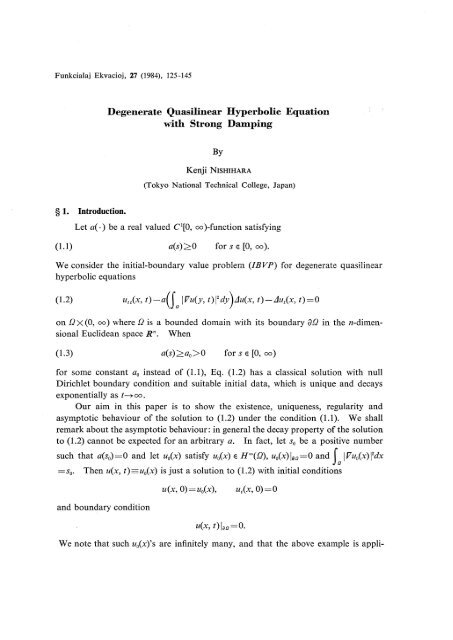


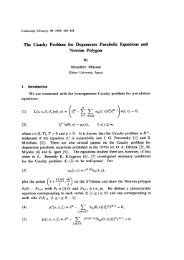
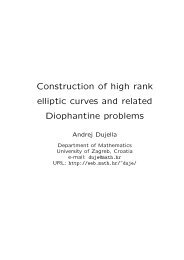
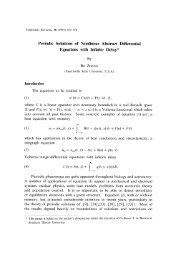
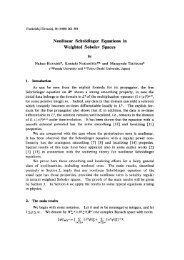

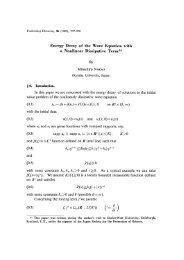
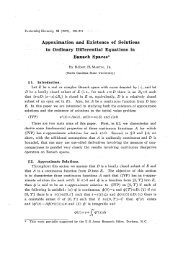
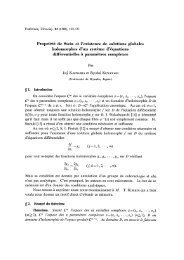
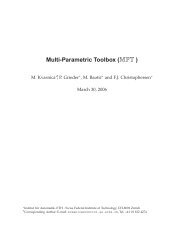

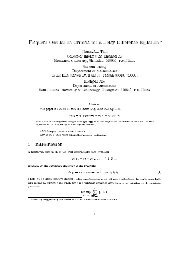
![The Proof of the Painleve Property by Masuo Hukuhara [4]$)$ in [1].](https://img.yumpu.com/16500459/1/184x260/the-proof-of-the-painleve-property-by-masuo-hukuhara-4-in-1.jpg?quality=85)